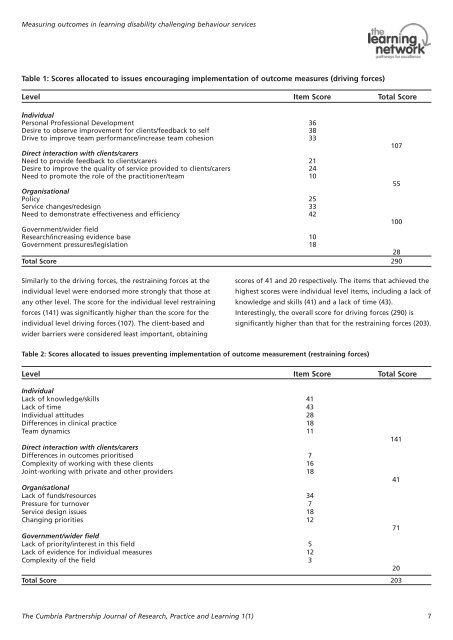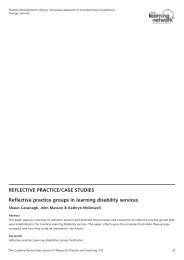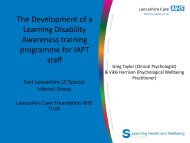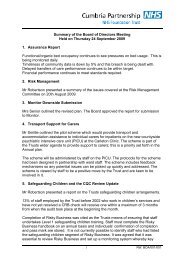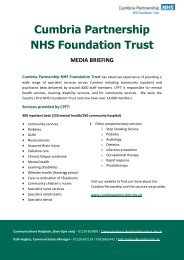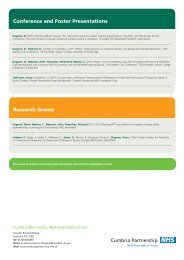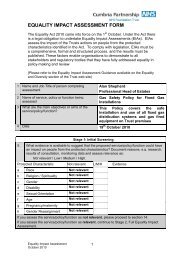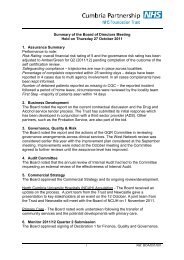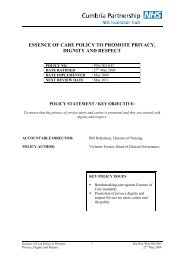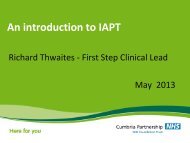RESEARCH REPORTS Measuring outcomes in learning disability ...
RESEARCH REPORTS Measuring outcomes in learning disability ...
RESEARCH REPORTS Measuring outcomes in learning disability ...
Create successful ePaper yourself
Turn your PDF publications into a flip-book with our unique Google optimized e-Paper software.
<strong>Measur<strong>in</strong>g</strong> <strong>outcomes</strong> <strong>in</strong> learn<strong>in</strong>g <strong>disability</strong> challeng<strong>in</strong>g behaviour servicesTable 1: Scores allocated to issues encourag<strong>in</strong>g implementation of outcome measures (driv<strong>in</strong>g forces)Level Item Score Total ScoreIndividualPersonal Professional Development 36Desire to observe improvement for clients/feedback to self 38Drive to improve team performance/<strong>in</strong>crease team cohesion 33Direct <strong>in</strong>teraction with clients/carersNeed to provide feedback to clients/carers 21Desire to improve the quality of service provided to clients/carers 24Need to promote the role of the practitioner/team 10OrganisationalPolicy 25Service changes/redesign 33Need to demonstrate effectiveness and efficiency 42Government/wider fieldResearch/<strong>in</strong>creas<strong>in</strong>g evidence base 10Government pressures/legislation 1828Total Score 29010755100Similarly to the driv<strong>in</strong>g forces, the restra<strong>in</strong><strong>in</strong>g forces at the<strong>in</strong>dividual level were endorsed more strongly that those atany other level. The score for the <strong>in</strong>dividual level restra<strong>in</strong><strong>in</strong>gforces (141) was significantly higher than the score for the<strong>in</strong>dividual level driv<strong>in</strong>g forces (107). The client-based andwider barriers were considered least important, obta<strong>in</strong><strong>in</strong>gscores of 41 and 20 respectively. The items that achieved thehighest scores were <strong>in</strong>dividual level items, <strong>in</strong>clud<strong>in</strong>g a lack ofknowledge and skills (41) and a lack of time (43).Interest<strong>in</strong>gly, the overall score for driv<strong>in</strong>g forces (290) issignificantly higher than that for the restra<strong>in</strong><strong>in</strong>g forces (203).Table 2: Scores allocated to issues prevent<strong>in</strong>g implementation of outcome measurement (restra<strong>in</strong><strong>in</strong>g forces)Level Item Score Total ScoreIndividualLack of knowledge/skills 41Lack of time 43Individual attitudes 28Differences <strong>in</strong> cl<strong>in</strong>ical practice 18Team dynamics 11141Direct <strong>in</strong>teraction with clients/carersDifferences <strong>in</strong> <strong>outcomes</strong> prioritised 7Complexity of work<strong>in</strong>g with these clients 16Jo<strong>in</strong>t-work<strong>in</strong>g with private and other providers 1841OrganisationalLack of funds/resources 34Pressure for turnover 7Service design issues 18Chang<strong>in</strong>g priorities 1271Government/wider fieldLack of priority/<strong>in</strong>terest <strong>in</strong> this field 5Lack of evidence for <strong>in</strong>dividual measures 12Complexity of the field 320Total Score 203The Cumbria Partnership Journal of Research, Practice and Learn<strong>in</strong>g 1(1) 7


